Bidding farewell to 2011

As twilight of the millennium’s eleventh year is slowly creeping in to give way to the dawn of New Year, IPConnect reminisces and recalls the stirring, evocative and thought provoking events. From the World Cup Victory to magnificent Formula One race in India, from Virender Sehwag smashing a handsome double century in Indore to “Kolaveri Di” breaking the north south divide, from Royal vows (read William-Kate) to gauche wedding (read Kris-Kim), Anna and his “Anshan”, Bachchans and their baby, the year has its fare share of “news” and “newsmakers”. IPConnect takes this opportunity to present a quick recap of the IP news that kept our newsletter resplendent with crisp news throughout the year.
Blunder of the year
Move over missed deadlines, here comes missing files. In response to a petition filed by Haldiram Pvt. Ltd. asking for inspection of certain trademark registration and opposition files which were related to pending litigation in court, it was revealed that the Trade Marks Registry of India has misplaced 44,404 files.
Move over missed deadlines, here comes missing files. In response to a petition filed by Haldiram Pvt. Ltd. asking for inspection of certain trademark registration and opposition files which were related to pending litigation in court, it was revealed that the Trade Marks Registry of India has misplaced 44,404 files.
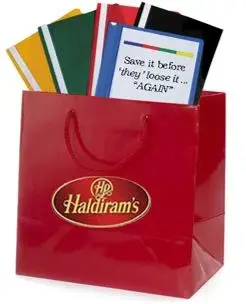
An affidavit filed by the Department of Industrial Policy and Promotion (DIPP) stated that files were misplaced while decentralizing the Registry’s office in Mumbai and transferring them to branch offices in other cities. As if it was not enough the public notice issued by the Control General of Patents Design and Trademarks (CGPDTM) listed lesser file numbers (36891) than the reported numbers that went missing. The Registry later promised to correct the error and further list all those file numbers that were not previously included.
Later, in a public notice issued by CGPDTM it was declared that pursuant to the steps taken by the Registry and through co-operation of the registered proprietors the number of physical missing registered trademarks files was reduced to 8183. However this was not before we made a laughing stock of ourselves before the world.
Tax benefits for filing Patent applications
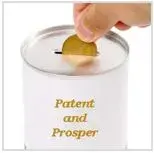
A draft of the sub-working group (SWG) on regulatory issues for pharma sector for 12th Five-Year plan has proposed that tax benefits given to drug makers should be extended for in house R & D and other research work conducted outside the firm including clinical trials, bio equivalence studies, regulatory approvals and patent filings.
SWG has also proposed a modification in minimum alternate tax (MAT) structure. Looks like filing patents can reap benefits other than protecting the intellectual property assets of the pharmaceutical companies.
Novartis Patent: To be or not to be
Justice Dalveer Bhandari, a Supreme Court judge recused himself from hearing Novartis AG’S patent plea for Glivec following media reports that he had attended at-least two international conferences organized by a body with which the company was associated. Justice Dalveer Bhandari was heading the bench before which the case was listed for hearing. The Swiss pharmaceutical company Novartis’ case was against a provision of patent law (Section 3(d) of the Indian Patent Act) aimed at preventing the extension of drug patents for minor changes in existing products, a practice known as ever greening.
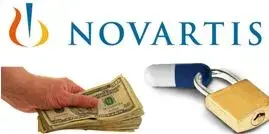
The original patent for Glivec was filed by Novartis in 1993 for the ‘amorphous’ molecule of the chemical, Imatinib Mesylate. In the late 1990s Novartis filed a fresh patent for the Beta variant of the molecule. They claimed that the Beta variety is better absorbed by the body. The 1993 patent was not recognized in India as at that time Indian law did not allow patenting of medicines. When the law was changed in 2005, Novartis applied for a patent for the Beta variety of the salt. The Patent Office rejected the patent and opined that under Indian law a slightly modified version of a known molecule cannot be patented. Novartis persisted in its efforts to get a patent and appealed to the Patent Appellate Board. When the Board rejected Novartis’ application again the company challenged the decision in the Chennai High Court. It also challenged the provision of the Indian Patent Act, which had been cited by the Patent office while rejecting the Glivec patent application. The Chennai High Court rejected both the appeals by Novartis. The case is now pending before the Supreme Court of India.
Non-governmental groups and HIV/AIDS activists are concerned that if the Supreme Court overturns Section 3(d) of the patent law it could undermine India’s generic drug industry, which provides the majority of the developing world’s affordable medicines. The leap would also result into a lot more number of patents to be granted in India than what normally are. The generic markets would decline and the prices would remain high for ever.
Compulsory License: The “oxymoronic” clause of the Patent Act.
Last year Natco Pharma had applied for the country’s first compulsory license to sell a generic version of Bayer’s patented medicine Nexavar. Bayer’s drug, Nexavar, which is used to treat liver and kidney cancer, costs about Rs. 2.85 lakh for a month’s course. Natco said it can sell its generic version, sorafenib tosylate, for just Rs. 8,900 for the same course.
Local drug firms and health activists are lobbying for the use of compulsory licensing on the grounds that innovator companies charge exorbitantly high prices for their medicines. Earlier Natco had sought a voluntary license from Bayer for sorafenib tosylate that was refused. Indian laws allow a firm to apply for a compulsory license only after the innovator company rejects the voluntary request.
Although compulsory licensing allows a generic firm to legally make and sell the low-cost version, it has to pay some royalty, usually about 5% of sales. MNCs strongly oppose the use of this provision because it breaks their monopoly. They say such licensing is not a sustainable policy to address access of medicines as these products account for much less than 1% of Indian drug market.
Keeping in view the cost and time spent on the research and development of any new drug, granting of compulsory license without addressing key issues would be a major setback for the drug discovery and development programs in India.
New “Copyright” tunes:
The Bombay High Court had ruled in favor of the Music Broadcast Pvt. Ltd in July this year seeking a declaration that the Indian Performing Right Society (IPRS) was not entitled to demand and receive any license fee or royalty for broadcast of sound recordings on its FM radio stations. The Court held that once the author of a lyric or a musical work parts with his copyright by authorizing the producer of a sound recording in respect of his work and thereby to have his work incorporated or recorded in the sound recording, the producer of the sound recording acquires copyright, which gives him the exclusive rights.
The FM radio stations that were paying separately to both music producers and copyright societies such as the IPRS, which administer rights of lyricists, music composers, will now be required to pay only to the music producers — the owners of the sound recording. The IPRS however claims that they would take necessary legal steps to appeal against the said judgments.
Copyright awareness in the Film industry
From borrowing scripts and tunes to lifting banners and posters entertainment industry around the globe has surely given new dimensions and meaning to inspiration. IPConnect offers its viewers a glimpse of some of the spiciest controversies and copyright infringement issues that surfaced this year:
Jolie’s common theme
Angelina Jolie’s directorial debut In the Land of Blood and Honey that released last week was alleged to be an infringement of the copyrighted work of a Croatian author, James Braddock. As claimed by the Plaintiff his book The Soul Shattering (2007) and the movie both tell the story of woman who is imprisoned in war torn Bosnia in the 1900’s. The author also claimed that he discussed his work in detail with the film’s Bosnian producer before Jolie’s movie was made.
The plaintiff had filed a motion for a temporary restraining order but this was dismissed and the movie went on to be released on the pre-decided date. The author (plaintiff) confessed that although he knew about the movie being made he had planned to sue the movie makers just before the release. U.S. District Judge Robert Dow, Jr. in Illinois said in a hearing last week that there were valid concerns about the timing of the lawsuit and suggested that the late filing would be a consideration when examining equities, harm and the public interest. The judge also noted that the plaintiff hadn’t yet shown that “immediate and irreparable harm would result” from the film’s release.
Spiderman caught in the web
On November 8, 2011 director/writer Julie Taymor filed a lawsuit seeking permanent injunction barring the show Spider Man: Turn off the dark from using her copyrighted elements without compensation. In the lawsuit she alleged that the adapted version of her stage directions and dialogue currently playing on Broadway constitute copyright infringement
Julie Taymor who was removed from the Broadway Musicals Production claimed that the revised show was still based on, copied and derived from Taymor’s copyrighted 2004 treatment and her original book further alleged that she suffered in excess of US$1 million in damages.
In her complaint, Julie Taymor & Loh, Inc. v. 8 Legged Productions, LLC et al (Case No. 1:2011-cv-08002), the plaintiff had specifically alleged that the musical’s producers, Glen Berger, Jeremiah Harris and Michael Cohl, breached a contract that gave her approval rights over changes to the play’s book and owe her royalties for performances since April when the production was revamped.
No Respite for Rihanna
Pop singer Rihanna’s music video “S&M” was caught in an allegation for copyright violation. German photographer Paulus had accused the singer for lifting the idea from one of his photographic series “Paperworld”. The dispute was over a scene where Rihanna is shown wearing a big dress, up against the wall with huge plastic in front of her, and with X’s all around.
In February, David LaChappelle had made the similar allegation and had sued the singer for copyright infringement. The photographer had claimed that eight of his images for past Vogue Italia photo shoots had been used by the singer. Rihanna and the defendant record labels had then retorted back saying that LaChapelle was “effectively trying to monopolize an entire subject matter or genre in two different mediums, i.e., still and motion picture formats.”
Think before you “ink”
The tattoo design that Mike Tyson has on the side of his face became the object of copyright violation issue at a federal court in the US. The artist who designed the said tattoo could not bear the fact that it was copied and used in a much awaited Hollywood movie ‘Hangover 2’ and went ahead to file infringement suit against the movie producers stressing that they never took his permission for such portrayal.
The remarks of the judge supported the tattoo designer stating that the subject in hand had a “strong likelihood of prevailing on the merits for copyright infringement” and on further arguments by Warner Bros. “this was an exact copy. It’s not a parody”. The Judge however had refused to delay the release of the film only on the grounds of ‘public interest’ explaining that the harm to the public interest from stopping the release of the movie outweighed the harm to the plaintiff. Both parties have though settled the dispute anyhow.
From the IP Office:
- The request to Registrar for official search specified in Rule 24 of the Trade Marks Rules, 2002 was discontinued and for the convenience of the public and users of the system free public search was made available in IPO official website. However the fee for filing of application to register a trade mark for a specification of goods or services included in one class was increased from Rs.2,500/- to Rs.3,500 /.
- DIPP issued a discussion paper on the possibility of granting patents for Utility Models and sought specific views and suggestions on the same. The underlying objective was to develop a suitable framework for protecting utility models, in the event of it being desirable. The Department hoped to generate informed discussion on the subject to enable the Government to take an appropriate policy decision.
- The Indian Patent Office issued a circular regarding the examination of patent applications and consideration of report of examiner by the Controller. The circular has been issued to overcome the delay in the examination process and issue of the First Examination Report (FER) as well as final disposal of the Patent Applications. Among other important guidelines, the Examiners were directed to quote relevant paragraphs of the prior art citations affecting the patentability of the claims and to provide cogent reason and justification for raising objections on novelty and/or inventive step. The highlight of the circular was the directions for non issuance of the Second Examination Report in case of any outstanding objection after the FER.
- DIPP released a discussion paper on the ‘Review of organizational structure of the Office of the Controller General of Patents, Designs, Trade Marks and Geographical Indications’. The ‘discussion paper’ sought to examine the steps that can be taken to enhance the efficacy of the patents & trademark offices. The paper suggested constitution of a separate full-fledged Registry for Trademarks and Geographical Indications as a distinct and independent entity from the office of the Controller of Patents and Design with a view to consolidate its functioning and bring synergy in its operations. The paper further suggested that the IP Office may be made into an autonomous agency of the Government and allow it to generate and retain the revenue from its functions.
- The Central Government vide its notification has proposed to amend certain rules in Trade Mark Rule, 2002 for making for making e-filing of Trademark application mandatory.
- The Annual Reports of the Patent Office reflected the affect of recessions. Barring trademarks, the global financial crises affected the overall filing rate of applications in India; consequently the office of CGPDTM witnessed a 5% reduction in generation of revenue in 2009-10. There was 6.8% decrease in patent filing and a reduction of about 7% in Design filing.
- The Manual of Patent Office practice and procedure, Manual of GI practice and procedure and the Manual of Designs were all finalized and published by the Patent Office.
- The DIPP successfully completed the procedure of appointing new Patent Examiners. The measure would have positive implication on the huge backlog of pending applications.
S. S. Rana & Co.’s contribution in IPR sensitization.
S.S. Rana & Co. takes keen interest in disseminating the vast knowledge of intellectual property rights to educate students, academicians, processionals and other people to make them aware of the different forms of IPRs and the various ways in which one can protect intellectual property and prosper business. We take up opportunities that help in propagating the theme of dissemination of knowledge.
Some of the contributions made by the firm in 2011 are delineated below:
- Managing Partner Mr. Vikrant Rana delivered a lecture on “Trademark search and new issues in trademark” on 27th April 2011 at Technology Information Forecasting and Assessment Council as part of the Orientation Program for the Woman Scientist Scholarship Scheme by the Department of Science and Technology (DST).
- Mr. Vikrant Rana made a presentation on “Trademarks and their importance to small scale industries” on 1st July 2011 at Rajkumar Goel Engineering College, Ghaziabad. For better understanding he highlighted the relevance of trademarks to the small scale industries in Ghaziabad.
- Ms. Rishu Srivastava, Patent Agent, participated in the Design Awareness Program on Blue Pottery held on 27thJuly 2011 at Jaipur and talked about Intellectual Property Rights in order to sensitize and educate people engaged in Blue Pottery and the benefits of registering their designs. The event was organized by Federation of Indian Chambers of Commerce and Industry (FICCI) and Rural Non-Farm Development Agency (RUDA) Jaipur, Government of Rajasthan and supported by Ministry of MSME (Micro small medium enterprises) Government of India, in coordination with National Institute of Design, Ahmadabad.
- Mr. Vikrant Rana gave a presentation on “Trademark and their relevance for the technologist” on 23rd August 2011 at The Energy Research Institute (TERI) Retreat, Gurgaon.
- Mr. Vikrant Rana presented a lecture on “National Strategy for Innovation and Competiveness; Focus on Innovation and Branding for International Competitiveness; Enhancement of product marketability through trademark and designs on 10th October 2011 at the India National Forum on sharing of best practices on Intellectual Property for Micro, Small and Medium-Sized Enterprises for Policy Maker in New Delhi. The conference was organized by Confederation of Indian Industry (CII) in collaboration with World Intellectual Property Organization (WIPO).
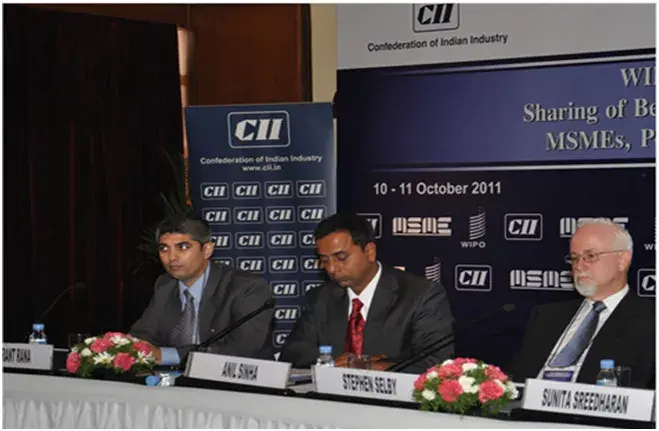
Mr. Vikrant Rana, Managing Partner S. S. Rana & Co., sharing his views at the forum organized by CII in collaboration with WIPO.
- Ms. Rishu Srivastava and Patent Analyst Ms . Divya Pandey contributed in the Discussion paper issued by the Department of Industrial Policy and Promotion (DIPP) in June 2011 and provided their viewpoints and feedback on the issues regarding Utility Models in India.
- Ms. Rishu Srivastava and Ms. Divya Pandey’s paper on Managing IPR in Publishing was selected and published by FICCI. The paper was distributed amongst all the participants of the “PubliCon – 2011 conference organized by FICCI in New Delhi on September 28-29, 2011.
- Senior Associate-Advocate Ms. Lucy Rana and Advocate Ms. Pooja Thakur submitted a paper on the Review of Organizational structure of the Office of the Controller General of Patents, Designs, Trademarks and Geographical Indications, in response to the discussion paper issued by DIPP in November2011.
- Mr. Vikrant Rana worked as one of the resource persons and contributed in the IP booklets on trademark & design prepared by CII to be used in the Intellectual Property (IP) training programs conducted by CII for the Innovation Clusters –Clusters identified by National Informatics Centre (NIC).
Farewell of the year:
After revamping the Patent Office and bringing several noteworthy reforms that included digitalization of the application procedure, making the status of the applications available online and providing free online trademark searches, Mr. P.H. Kurian (IAS), the Controller General of Patents, Designs and Trademarks (India) announced his resignation even before the completion of his tenure.
Mr. Kurian who took charge of the Intellectual Property Office in February 2009 was single handedly responsible for the modernization and strengthening of IP Offices. There are speculations that he may to join as Principal Secretary in the Kerala Government.
IPConnect’s tribute to the legendry Steve Jobs:
Steve Jobs; the apple of i-World (1974-2011)
For the past 33 years, I have looked in the mirror every morning and asked myself: ‘If today were the last day of my life, would I want to do what I am about to do today?’ And whenever the answer has been ‘No’ for too many days in a row, I know I need to change something.
–Steve Jobs

Jobs was an inventor, a world class marketer, a design genius and someone who understood exactly what can be achieved by putting IP in all its forms at the heart of corporate strategy. With over three hundred patents he was supposedly the only CEO having the highest number of patents in his name. His name appears on the patent for the first iPod design. His name is on the patents of various laptop designs. He even holds 13 different patents for the unique packaging of iPhones and iPods.
IPConnect offers tribute to a Visionary leader who was in more than one way responsible for success of Apple Inc.
Factopedia presents some amazing and amusing patent to light up the New Year
- Collar apparatus enabling secure handling of a snake by tether
US Patent No. 6,490,999
Issued December 10, 2002
The present invention is in the field of pet supplies and pertains more particularly to a collar apparatus for enabling tethering and subsequent walking of a pet snake. Taking the snake out for a walk is just the kind of invention the world needed… Bravo.
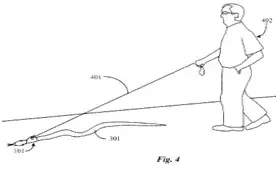
- Airplane Hijacking Injector
United States Patent 3841328
Issued October 15, 1974
The invention is a passenger disabling apparatus that is mounted in and under an airplane seat and remotely actuated by a pilot or a crew member for disabling an airplane hijacker.
One important requirement of this invention is a very polite hijacker who is obedient enough to go back to his seat and buckle up once he notifies his intentions.
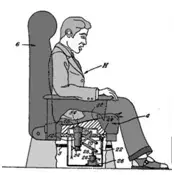
- Portable automobile partition
Patent No. 6,260,903
Issued: July 17, 2001
Children seated in a rear seat of an automobile may engage in squabbling, fighting, or other behavior that may be distracting to the driver. The partition plate typically extends vertically so that its top edge is near to the ceiling of the automobile, and its back edge is shaped to conform to the shape of the seat back. Thus, children respectively seated on a cushion or child seat on top of the two portions of the seat plate are separated from each other by the partition. Imagine the plight of the restless kid.
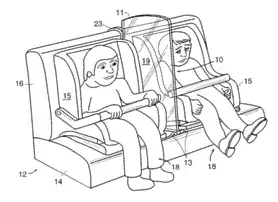
- Life expectancy timepiece
Patent no. 5,031,161
Issued July 9, 1991
A timepiece for monitoring and displaying the approximate time remaining in a user’s life. The monitoring apparatus is programmed to decrement time units from an actuarially determined lifespan and to shift a projected lifespan value as the individual grows older. The person using this may just die out of anticipation if not anything else.
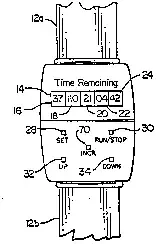
- Device for Waking Persons from Sleep
Patent No. 256,265
Issued: April 11, 1882
Ordinary bell or rattle alarms are not at all times effective for their intended purpose, as a person in time becomes so accustomed to the noise that sleep is not disturbed when the alarm is sounded. The main aim of the invention is to provide a device which will not be liable to this objection. This looks less like the device for waking people from sleep and more like a heart attack inducing apparatus.
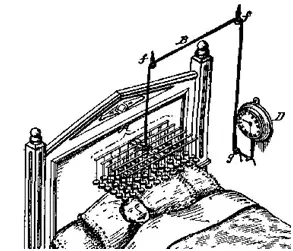
- Reminder and enforcer apparatus
Patent No. 4,764,111
Issued: August 16, 1988
A device for reminding kids to wear their braces, involving implanting an alarm in their mouths with a timer. A magnet on the braces shuts off the alarm. The children would learn by themselves never to forget for the fear of alarm implants in their mouths.
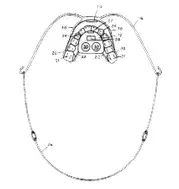
From the editors:
Shakespeare once said “The evil that men do lives after them; the good is oft interred with their bones” but then he also said “How far that little candle throws its beams! So shines a good deed in a naughty world”
The act of kindness, brining a smile to someone, showing generosity and helping others with selfless motives is what makes man a human being. Compassion is a great way to help oneself as it makes life meaningful and brings satisfaction, joy and contentment in life.
We at S. S. Rana & Co. believe that it is our moral responsibility to help the impoverished and needy sect of the society. As a part of belief and dedication towards society, our trust Vidya Darshan Rana Charitable Trust providefinancial assistance to the needy family members of support staff and daily wagers working in the Delhi High Court premises and offer support in organizing marriage of poor orphan girls.
The Trust also supported the Indian National under-21 Women’s Hockey team, which had participated in the 4-Nation Lal Bahadur Shastri Hockey Tournament held in New Delhi in November 2011. We offered this sponsorship not only for the love of the game, which happens to be our national game but also to motivate the Hockey players to perform better on the field.
perform better on the field.
(From Left to Right) Mr. Sohan Singh Rana & Mrs. Bindra Rana, founders of Vidya Darshan Rana Charitable trust with the Indian National under-21 Women’s Hockey Team
We also believe that India has huge untapped potential and therefore support the cause of grassroots innovators to enable them to exploit the burgeoning rural industries in India. We are always eager to offer Pro Bono services and be associated with deserving causes and provide legal and monetary aid to local organizations, deserving grassroots innovators, artisans and creators. We also appreciate the initiatives and effective steps taken by organizations like the Honey Bee Network, National Innovation Foundation (NIF), Society for Research and Initiatives for Sustainable Technologies and Institutions (SRISHTI), Grassroots Innovation Augmentation Network (GIAN) and the likes to encourage students, scientists, inventors and innovators to come up with solutions for the problems we face in the technically lacking areas.
To sum up, we would like to state that it does not take long to realize that there are indeed people out there who need help and encouragement. As William Shakespeare would say:
“The quality of mercy is not strain’d,
It droppeth as the gentle rain from heaven
Upon the place beneath. It is twice blest:
It blesseth him that gives and him that takes.”
With this issue IPConnect takes the opportunity to wish all its readers a very warm, happy and prosperous New Year.








